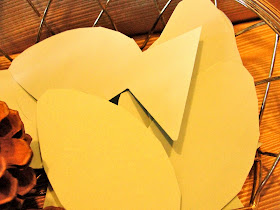The Solemnity of St. Joseph is one of our favorite liturgical days to celebrate. Between our love of the Saint himself and the fact that it interrupts Lent by ceasing all fasting, makes this feast day an easy winner. We began hosting an annual party to celebrate with friends and are in the midst of preparing the house and altar for 40 guests right now. I wanted to interrupt the prep to share with you the symbols and meaning of each item on our altar.
To begin, the tradition of making a St. Joseph's Day altar started after a devastating drought brought famine to Sicily many years ago. After seeking the intercession of their patron St. Joseph, rain poured down and nourished their crops.
There are three tiers to the altar, representing the Trinity and the three members of the Holy Family; Jesus, Mary, and Joseph. A statue or picture of St. Joseph, white lilies (the store only had tiger lilies and the others were a gift) and candles are staples of a St. Joseph's altar.
There are three tiers to the altar, representing the Trinity and the three members of the Holy Family; Jesus, Mary, and Joseph. A statue or picture of St. Joseph, white lilies (the store only had tiger lilies and the others were a gift) and candles are staples of a St. Joseph's altar.
Next comes the food... and lots of it. Below is most of the traditional fare, but items vary depending on local customs and traditions.
Sfinge di San Giuseppe (Cream Puffs of St. Joseph)
Simply the traditional treat of any St. Joseph’s day. Sfinge is to St. Joseph’s day as turkey is to Thanksgiving. I hear pastry shops in Italy sell these by the thousands for the Solemnity. It's true, ours hail from the freezer section of the grocery store. If you are brave try making these from Catholic Cuisine.
Breads Shaped into Symbols
Several breads are made that represent both Jesus and St. Joseph. The symbols include ladders, hammers, nails, saws, lilies, and a staff for St. Joseph; and crosses, palms and wreaths (for the crown of thorns) for Jesus. We cheated and used canned Pillsbury crescent rolls to make our, but if you want to be authentic a recipe is here at Catholic Culture.
Pupa Cu L'ova
Another traditional bread includes adding whole dyed Easter eggs. This serves to remind us that Easter is coming! I just put plastic eggs in circular Pillsbury rolls, POST baking. It only took one can to make all of the pup cu l'ova and symbol breads above. Check out some of these authentic examples!
Symbolic Fig Filled Pastries
Pastries filled with dried figs represent the fig orchards of Sicily. Authentic fig pastries are detailed works of art that are not edible. The symbols can include a monstrance, chalice, cross, fish, Bible or heart. Ours are made out of fig newtons, thank you Lacy from Catholic Icing for your brilliant idea!
Fish
The 12 fish represent the 12 apostles. You’ll notice that there is not meat at a St. Joseph’s altar. This is because the Feast of St. Joseph is always celebrated during Lent! We opted to make paper fish so the alter wouldn’t smell fishy.
Fava Beans
The fava bean was the main food that kept families in Sicily alive during the drought. Italians would carry this "lucky bean" with them for good fortune. These are lima beans, sorry, but you get the idea.
Pignolatti
This treat is a pine cone shaped fried pastry, which serves as a reminder of the pine cones Jesus played with as a child. Not sure where they got the idea that Jesus played with pinecones. We just put out pinecones, certainly not edible. Check out the read deal at Gourmet with Me.
Our friends will be bringing over other delicious desserts and drinks to complete the feasting in 15 mintues! Gotta go!
Check out Catholic Icing for more ideas!










